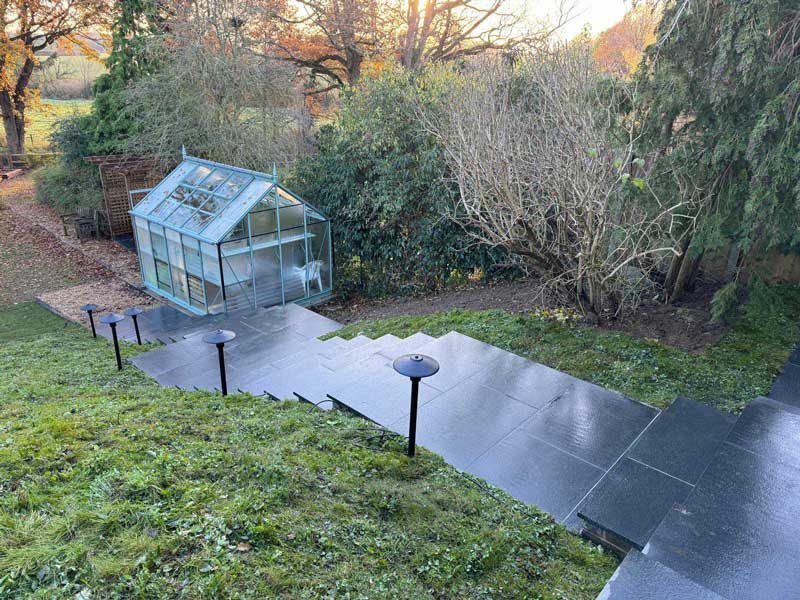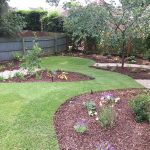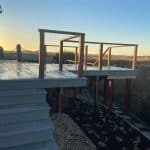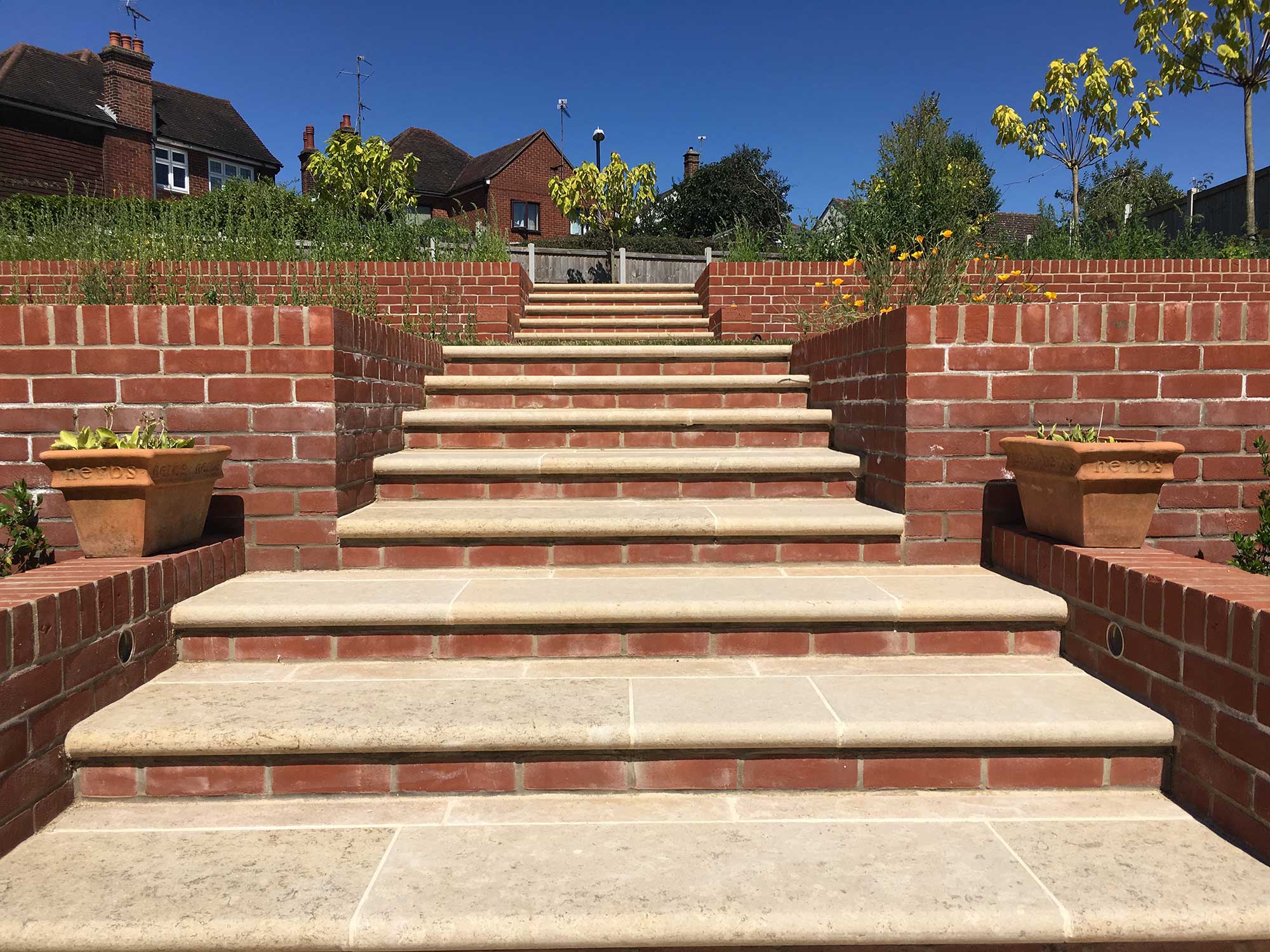04 Apr Sloping Garden Ideas To Inspire Your Next Outdoor Project
A selection of sloping garden ideas to suit outdoor spaces of all shapes and sizes.
At Holland Landscapes we’re lucky enough to be based in a wonderful part of the UK where gently rolling hills make for an interesting landscape. Hills and slopes, dips and hollows are wonderful when it comes to creating intrigue in a space. Every time I explore a different walk with the dogs I find myself wondering “what’s down there?” Or “what will I see from the top of this hill?”
When a client asks for sloping garden ideas, the Holland Landscapes team have no shortage of suggestions. During our three and a half decades of building gardens, we’ve encountered quite a few slopes. Living in this part of Essex, they’re unavoidable. We’re blessed with beautiful rolling countryside, stunning vistas and intriguing landscape features as well as some wonderful open gardens where we can learn from famous landscapers such as Capability Brown, Harold Pete and Beth Chatto.
Working with our in-house garden designers, Tapestry Design Studios our team can turn a difficult sloping garden into a small piece of paradise. With easy access to all areas, reliable drainage, great views, seating areas and practical spaces for cooking, eating and relaxing our gardens are designed and built to suit your tastes, your needs and your budget.
Let’s take a look at some examples.
Idea For A Sloping Front Garden
This sloping garden in Colchester posed a problem for the homeowner. He really wanted formal lawns surrounded by lush planting, but the slanting angle of the plot made lawn care difficult.
Creating a series of flat terraces – rather like raised beds – made it possible to level out the lawns and create strategically place planting beds. A carefully chosen plant palette creates a welcoming ambience to the front of this property.
Ideas For Steeply Sloping Back Gardens
These two gardens are similar in that they fall away from the house quite dramatically. However our approach to landscaping them was somewhat different.
Why the different designs? Well, as with any home improvement project, budget is a prime consideration. Building steps, terraces and retaining walls involves moving soil, digging footings and buying the relevant materials. In each of these cases, the solution was costed out during the design process to ensure that our clients were happy with the end quote.
We also consider the view from every part of the garden – in one of these projects there are magnificent views of the surrounding countryside. In the other there are neighbouring properties in all directions.
Access is a major consideration for sloping gardens. In general there are two ways to tackle access on a slope. Steps or ramps. For anyone with mobility challenges, ramps are often an easier solution. Provided or course, they are not too steep. A gradient of 1:12 is normally recommended for wheelchair friendly access.

Two flights of well-lit steps lead from a generous patio, down a slope cloaked with wildflowers, to the lower levels of the garden.

In this sloping garden, the soil has been contoured and landscaped to create a lovely grassy ramp. A set of rustic steps can also be used to traverse the slope.
Tackling Gardens That Slope Towards A Property
Ideas for sloping gardens must always bear in mind what will happen when it rains. When the ground slopes away from the property, landscapers want to be sure that a garden makeover won’t push excess water onto neighbouring land. When the garden slopes towards the property, we work extra hard to ensure that stormwater is directed away from the home.
In this garden near Ongar, there’s quite a difference between the level of the garden and the level of the cottage. As you can see in the ‘before’ picture there wasn’t much room for efficient drainage or airflow between the garden wall and the cottage wall.
Moving soil away from the house has created a wide, open terrace with lots of room for seating and outdoor activities. The terrace is hugged by banks of wildflowers whose roots stabilise the slope. Wide, sturdy steps invite garden users to explore the lawns, and the views, beyond the patio.

Before landscaping this sloping garden was encroaching upon the property

After landscaping. The slope has been repositioned to allow for a generous outdoor dining area and large planting beds. The soft landscaping helps to absorb excess rainwater. The whole terrace is hugged by wildflower banks which offer a visual connection to the surrounding countryside.
Formal Sloping Garden
We’ve taken a similar approach, to the cottage garden above, but with very different styling to this garden in Colchester. A spacious patio beside the house leads towards two flights of steps. However, rather than choose soft slopes, our client opted for the clean lines of retaining walls and terraces.
The joy of planting on top of a retaining wall is that from one part of the garden, the plants are at eye level, but when you climb the steps, the flowers are at ground level, offering a whole other perspective on the planting.
Note the young trees planted at the back of the garden. These will quickly mature to offer privacy. This property is built at the bottom of a hill and is overlooked by homes higher up the slope. Our garden makeover sought to remedy that problem.

A more formal approach to a sloping garden with clean lines and geometric terraces.
Using Raised Structures To Overcome The Challenges Of A Slope
We’ve shown you some examples where steps or ramps have been used to give easier access around a sloping garden. But there is another way. Raised structures.
Lifting a walkway above the garden is a great way to even out slopes and still allow the garden to ‘do it’s own thing’.
If an undulating garden is prone to flooding in winter and drying out in summer, an ideal solution would be to create a rain garden. Somewhere that acts as a water feature for part of the year and resembles a dry river bed in summer would be wonderful. Especially when viewed from a raised platform. There’s a great example of this in East Ruston Old Vicarage Garden in Norfolk. It’s well worth a visit if you get the chance.
The picture below shows a raised deck we built for a holiday home in Great Bentley. The home sits atop a slope between the river and some marshy land. Using carefully engineered steels and Millboard composite decking, we solved two problems in one. The steep slope leading to the property became easy to climb. Plus our clients’ no longer need to navigate soggy ground to enjoy the views from their weekend get away home.

This sloping garden sits beneath a deck. By building a raised structure we have been able to create a generous terrace. Had we imported soil to build the garden up, the cost would have been prohibitive especially since this area is sometimes inclined to flood.
Have You Been Inspired?
I hope these sloping garden ideas have inspired you to make your own garden easier to navigate and manage. Don’t forget that our in-house designer, Katie from Tapestry Design Studios is able to offer garden design inspiration to householders throughout the UK. And if you are based in Essex or Suffolk, The Holland Landscapes Team would be honoured to bring those ideas to life for you.
Here’s how to get in touch.
Contact Katie at Tapestry Design Studios for inspirational garden ideas





Sorry, the comment form is closed at this time.